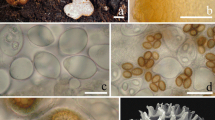Abstract
Based on morphological and molecular phylogenetic analysis, the new species Tuber glabrum is described from China, and the new name T. sinomonosporum is proposed for Paradoxa sinensis. Tuber glabrum is similar to T. gigantosporum but differs by its glabrous ascomata. The ITS sequences of the two Paradoxa-like truffle species, which invariably have one-spored asci, fall into the lineage of Tuber and cluster in a distinct clade together with the European T. macrosporum and the North American T. canaliculatum.


Similar content being viewed by others
Reference
Bonito GM, Gryganskyi AP, Trappe JM, Vilgalys R (2010a) A global meta-analysis of Tuber ITS rDNA sequences: species diversity, host associations and long-distance dispersal. Mol Ecol 19:4994–5008. doi:10.1111/j.1365-294X.2010.04855.x
Bonito G, Trappe JM, Rawlinson P, Vilgalys R (2010b) Improved resolution of major clades within Tuber and taxonomy of species within the Tuber gibbosum complex. Mycologia 102:1042–1057. doi:10.3852/09-213
Bonito G, Trappe JM, Donovan S, Vilgalys R (2011) The Asian black truffle Tuber indicum can form ectomycorrhizas with North American host plants and complete its life cycle in non-native soils. Fungal Ecol 4:83–93. doi:10.1016/j.funeco.2010.08.003
Bonito G, Smith ME, Nowak M, Healy RA, Guevara G, Cazares E, Kinoshita A, Nouhra ER, Dominguez LS, Tedersoo L, Murat C, Wang Y, Moreno BA, Pfister DH, Nara K, Zambonelli A, Trappe JM, Vilgalys R (2013) Historical biogeography and diversification of truffles in the tuberaceae and their newly identified southern hemisphere sister lineage. PLoS ONE 8(1):E52765. doi:10.1371/journal.pone.0052765
Brock PM, Doring H, Bidartondo MI (2009) How to know unknown fungi: the role of a herbarium. New Phytol 181:719–724. doi:10.1111/j.1469-8137.2008.02703.x
Dring DM (1971) Techniques for microscopic preparation. In: Booth C (ed) Methods in microbiology, vol 4. . Academic, New York, p 98
Fan L, Cao JZ (2012) Two new species of white truffle from China. Mycotaxon 121:297–305. doi:10.5248/121.297
Fan L, Cao JZ, Li Y (2012) Tuber microsphaerosporum and Paradoxa sinensis spp. nov. Mycotaxon 120:471–475. doi:10.5248/120.471
Fan L, Cao JZ, Li Y (2013) A reassessment of excavated Tuber species from China based on morphology and ITS rDNA sequence data. Mycotaxon (in press)
Ferdman Y, Aviram S, Roth-Bejerano N, Trappe JM, Kagan-Zur V (2005) Phylogenetic studies of Terfezia pfeilii and Choiromyces echinulatus (Pezizales) support new genera for southern African truffles: Kalaharituber and Eremiomyces. Mycol Res 109:237–245. doi:10.1017/S0953756204001789
Frank JL, Southworth D, Trappe JM (2006) NATS truffle and truffle-like fungi 13: Tuber quercicola and T. whetstonense, new species from Oregon, and T. candidum redescribed. Mycotaxon 95:229–240
Gilkey HM (1954) Tuberales. N Am Fl Ser II 1:1–36
Huelsenbeck JP, Ronquist F, Nielsen R, Bollback JP (2001) Bayesian inference of phylogeny and its impact on evolutionary biology. Science 294:2310–2314. doi:10.1126/science.1065889
Iotti M, Amicucci A, Stocchi V, Zambonelli A (2002) Morphological and molecular characterization of mycelia of some Tuber species in pure culture. New Phytol 155:499–505. doi:10.1046/j.1469-8137.2002.00486.x
Kinoshita A, Sasaki H, Nara K (2011) Phylogeny and diversity of Japanese truffles (Tuber spp.) inferred from sequences of four nuclear loci. Mycologia 103:779–794. doi:10.3852/10-138
Moreno G, Alvarado P, Manjon JL (2012) Phylogenetic affiliation of Choiromyces magnusii and C. venosus Tuberaceae (Ascomycota) from Spain. Mycol Prog 11:463–471. doi:10.1007/s11557-011-0762-1
Rambaut A (2000) Estimating the rate of molecular evolution: incorporating non-contemporaneous sequences into maximum likelihood phylogenies. Bioinformatics 16:395–399. doi:10.1093/bioinformatics/16.4.395
Riousset L, Riousset G, Chevalier G, Bardet MC (2001) Truffes d’Europe et de Chine. Institut National de la Recherche Agronomique, Paris
Ronquist F, Huelsenbeck JP (2003) MrBayes 3: Bayesian phylogenetic inference under mixed models. Bioinformatics 19:1572–1574. doi:10.1093/bioinformatics/btg180
Roux C, Sejalon-Delmas N, Martins M, Parguey-Leduc A, Dargent R, Becard G (1999) Phylogenetic relationships between European and Chinese truffles based on parsimony and distance analysis of ITS sequences. FEMS Microbiol Lett 180:147–155. doi:10.1111/j.1574-6968.1999.tb08789.x
Swofford DL (2002) PAUP*, phylogenetic analysis using parsimony (*and other methods), version 4. Sinauer, Sunderland
Thompson JD, Gibson TJ, Plewniak F, Jeanmougin F, Higgins DG (1997) The CLUSTALX windows interface: flexible strategies for multiple sequence alignment aided by quality analysis tools. Nucl Acids Res 24:4876–4882. doi:10.1093/nar/25.24.4876
Wang Y, Hu HT (2008) Paradoxa gigantospora comb. nov. from China. Mycotaxon 106:199–202
Wang Y, Li ZP (1991) A new species of Tuber from China. Acta Mycol Sin 10:263–265 (In Chinese)
Wang YJ, Tan ZM, Zhang DC, Murat C, Jeandroz S, Le Tacon F (2006) Phylogenetic relationships between Tuber pseudoexcavatum, a Chinese truffle, and other Tuber species based on parsimony and distance analysis of four different gene sequences. Microbiol Lett 281:259–269. doi:10.1111/j.1574-6968.2006.00283.x
White TJ, Bruns T, Lee S, Taylor J (1990) Amplification and direct sequencing of fungal ribosomal RNA genes for phylogenetics. In: Innis MA et al (eds) PCR Protocols: a Guide to Methods and Applications. Academic, San Diego, pp 315–322
Vizzini A (2003) Il genere Tuber: la sua posizione nelle Pezizales (origine dei taxa ipogei nelle Pezizales). Boll Gruppo Micol G. Bresadola 46 (n.s.): 97–153
Acknowledgments
The study was supported by the National Natural Science Foundation of China (No. 31270058) and the Beijing Natural Science Foundation (No. 5122003).
Author information
Authors and Affiliations
Corresponding author
Rights and permissions
About this article
Cite this article
Fan, L., Feng, S. & Cao, JZ. The phylogenetic position of Tuber glabrum sp. nov. and T. sinomonosporum nom. nov., two Paradoxa-like truffle species from China. Mycol Progress 13, 241–246 (2014). https://doi.org/10.1007/s11557-013-0908-4
Received:
Revised:
Accepted:
Published:
Issue Date:
DOI: https://doi.org/10.1007/s11557-013-0908-4




